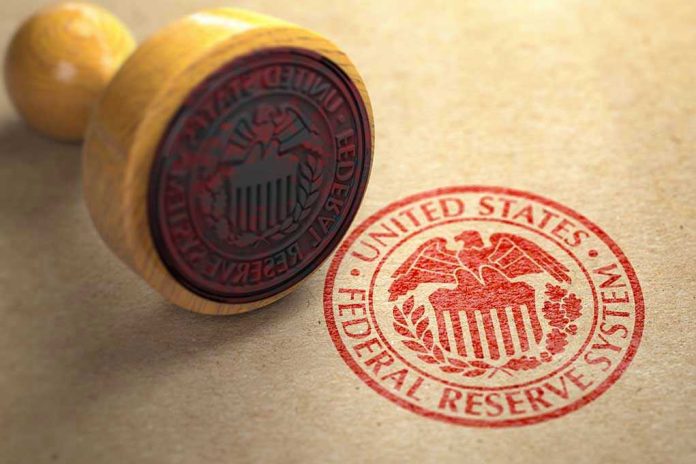
A split Federal Reserve just cut rates again, but Chair Powell’s warning sent markets into a frenzy: is the era of easy money truly over, or is this just the pause before the next storm?
Story Snapshot
- The Fed reduced its policy rate by 25 basis points, yet further cuts remain uncertain.
- Chair Jerome Powell emphasized a data-driven, cautious approach, diverging from market expectations.
- Dissent within the FOMC reveals deep internal divisions about inflation and recession risks.
- The simultaneous end of quantitative tightening adds another twist to the Fed’s policy trajectory.
Fed’s October Decision: Relief, Anxiety, and Puzzlement
The Federal Reserve’s October 2025 rate cut delivered momentary relief for borrowers and Wall Street, but the aftermath was anything but calm. By lowering the federal funds target to 3.75%–4.00%, the Fed signaled it saw enough economic headwinds to warrant a second reduction this year. Yet investors hoping for a predictable path of further cuts found no comfort. Powell’s remark that a December cut is “far from” certain injected a jolt of uncertainty, sending analysts scrambling to rework their forecasts and market participants bracing for volatility.
The FOMC’s vote revealed a stark split, with some members pushing for a deeper cut and others resisting any move at all. This lack of consensus not only fueled speculation about future policy but exposed the increasingly difficult balancing act facing the Fed. Dissent is not new, but the public airing of sharply divergent views has left economists and the public alike questioning whether the Fed’s once-reliable playbook still applies in an era of persistent inflation and unpredictable growth.
Historical Context: From Crisis Response to Deliberate Caution
Decades of monetary history color every Fed announcement, and the current caution is rooted in lessons learned from past crises. The aggressive rate hikes of 2022–2023 slammed the brakes on runaway inflation, but also risked tipping the economy into recession. As inflation moderated in 2024 and labor market data began to soften, the central bank pivoted, cutting rates and pausing further increases. Previous episodes—such as the near-zero rates of 2008 and the emergency responses in 2020—demonstrated the Fed’s willingness to act decisively, but also revealed the risks of moving too quickly or too slowly.
The current approach, described by Powell as “data dependent,” is more circumspect. The Fed navigates mixed signals: inflation remains above target, job growth is slowing, and government data lags due to shutdowns. Policymakers must balance the risk of reigniting inflation with the danger of stalling growth, a dilemma that has led to sharp divides within the committee and intense scrutiny from Congress, the media, and the public.
Internal Tensions: The FOMC’s Fractured Consensus
Behind the scenes, the Federal Open Market Committee is far from united. Governor Miran argued for a more aggressive 50 basis point cut, warning that employment risks demand stronger action. Kansas City’s President Schmid, on the other hand, voted against any cut, citing lingering inflation and the danger of undermining price stability. Powell’s role as Chair is pivotal; he must forge consensus from these divergent viewpoints while maintaining credibility with markets and the broader public.
Market expectations often run ahead of official statements, and the split vote sparked intense debate about whether the Fed is moving too cautiously or not cautiously enough. Borrowers and investors crave clarity, but the Fed’s caution signals that the old playbook may not fit the current economic puzzle. The simultaneous decision to end quantitative tightening on December 1 adds complexity, suggesting further efforts to support liquidity amid uncertainty.
Ripple Effects: Borrowers, Savers, and the Political Arena
Lower rates promise immediate relief for mortgage holders, credit card users, and small businesses hoping to expand. Yet savers and retirees face shrinking yields, and fixed-income investors must reckon with diminished returns. The labor market, still fragile, could stabilize if rate cuts spur growth, but inflation threatens to erode real wages. Each move reverberates through the financial system, impacting everything from homebuying to bank profitability and dollar strength.
Politically, the Fed’s actions are magnified in an election year. Lawmakers scrutinize every move, and Powell faces pressure from both sides to prioritize growth or price stability. The Fed’s independence is both shield and lightning rod, with critics ready to pounce if policy stumbles. Global markets monitor every signal, knowing that U.S. rate moves can trigger shifts in capital flows and currency values worldwide.
Expert Analysis: Navigating a Data-Dependent Future
Economists and market strategists agree that the Fed’s “data-dependent” mantra is more than rhetoric—it reflects the complexity of today’s landscape. Persistent inflation and rising unemployment risks challenge conventional wisdom, forcing policymakers to adapt on the fly. Analysts warn that further cuts may reignite inflation, while insufficient easing could spark recession. Professional commentary highlights the tension between short-term relief and long-term stability, with each FOMC meeting serving as a high-stakes chess match.
Major financial institutions and research firms scrutinize every statement for hints of future moves. The consensus: uncertainty reigns, and the Fed’s next step could set the tone for markets and the broader economy well into 2026. For now, all eyes remain on the data, the divisions within the FOMC, and Powell’s next word—knowing that the only constant is change.
Sources:
Charles Schwab: FOMC Meeting Coverage
U.S. Bank: Federal Reserve Interest Rate News
Trading Economics: U.S. Interest Rate Updates












